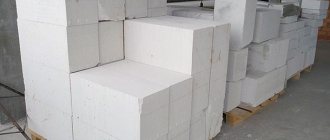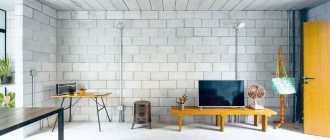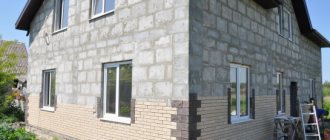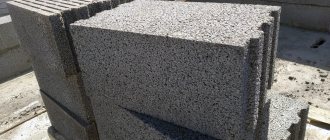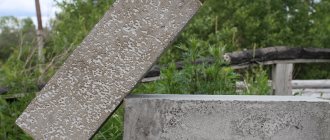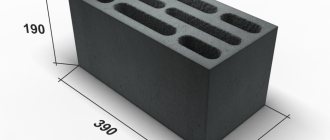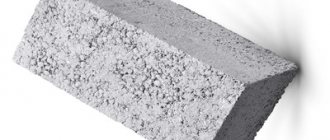At construction sites, masonry building materials for the construction of houses and the construction of partitions are presented in a wide range. Let's consider an option such as aerated concrete blocks, the pros and cons of porous concrete. Let's get acquainted with production technologies, technical characteristics, dimensions, and figure out how to determine the weight of the blocks. After reading the article, communicating with suppliers and workers will be much easier.
Aerated concrete garage Source m-strana.ru
Production of building material
To understand what aerated concrete blocks are, their advantages and disadvantages, you need to find out its composition. The basis for the production of aerated concrete is a mixture of cement, quartz, and aluminum powder. To adjust certain characteristics of the finished product, additional additives or substitutes for solid filler (gypsum, lime, ash, slag) can be used.
The binding component (M400, M500) provides a strong bond of fine-grained filler. Sand with a fraction of up to 2 mm can be mined anywhere, but it must first be cleaned of clay and biological inclusions.
Metal in the form of powder (PAP-1, PAP-2), paste or suspension is added to obtain a porous block structure. This result is achieved due to the chemical reaction of aluminum with alkali, the products of which are calcium salts and hydrogen gas.
Aluminum powder Source chellak-servis.ru
The thinner is pure industrial water. The dependence of the behavior of the solution on the temperature of the liquid medium was revealed. Therefore, the indicator is brought to at least +45℃. This approach has a positive effect on the strength characteristics and helps accelerate the hardening process of porous concrete. The possibility of reducing the portion of cement in the composition due to the increased chemical activity of the components is also noted.
The production of aerated concrete is regulated by strictly prescribed standards in the following documents:
- GOST 23732-79 (about water for preparing solutions);
- GOST 10178-85 (about cement binder).
To obtain blocks with a volume of one cube, you will need approximately 90 kg of Portland cement, 35 kg of lime, 375 kg of sand. After mixing the composition in dry form, add 0.5 kg of aluminum powder. Almost 300 liters of water are poured into a homogeneous mixture. These are standardized proportions, but each manufacturer develops its own recipe and specifications.
The pros and cons of aerated concrete in construction are determined not only by the composition, but also by the technology for manufacturing the blocks. There are two types of materials available for sale. The classification is carried out according to the type of production: with the participation of an autoclave or without an oven.
Autoclave oven Source znaybeton.ru
The process in the first stages is identical:
- the mixture and solution are prepared;
- the mass is poured into the mold (filling is 50%);
- 4-6 hours are allotted for the formation of pores;
- remove excess, cut workpieces;
- It takes up to 18 hours for the blocks to harden.
Without using an autoclave, the material must gain tempering strength, which takes 2-3 days. The products are then sent to the warehouse for another 3 weeks. Or the blanks are placed in a sealed chamber, where a pressure of up to 12 kg/sq.cm is created, and the aerated concrete is treated with hot water steam. The result is a building material of higher quality.
Disadvantages (cons):
- High hygroscopicity, therefore it is recommended to use this material in regions with low or average air humidity ;
- The material is quite fragile - should not be used in regions with seismological activity , since gas silicate reacts to the slightest deformations and movements of the soil. It is recommended to use a reliable, high foundation when building houses from gas silicate blocks.
- Low coefficient of mechanical strength - it is recommended to hang heavy thermal and waterproofing materials on gas silicate only using special fasteners and supporting structures.
Features Overview
When designing the construction of a house made of aerated blocks, the pros and cons of the material are considered from the point of view of technical indicators and physical parameters. Thus, pores with a diameter of up to 3 mm significantly reduce the weight of concrete, simplify the cutting of products, and have a positive effect on thermal insulation properties and the ability to absorb noise. To study the products in detail, you need to familiarize yourself with the labeling and purpose of individual types of gas blocks.
Block partition Source kladka-penoblokov.ru
Classification
Among the characteristics on which the pros and cons of building a wall made of aerated concrete are based are shape, strength, insulating properties, and purpose. Manufacturers mark their products for convenience. This is what is hidden under the symbols (D – density, 300 – value in kg/cub.m.):
- D300 is the most fragile type of aerated concrete, which has a relatively low thermal conductivity coefficient. This determines its insulating purpose.
- D400 is used for the construction of doorways, thermal insulation of load-bearing structures of a building 1 floor high.
- D500 is designed for monolithic construction of two-story houses.
- D600 is considered especially relevant for the construction of walls with ventilated facades.
There is also D300 brand material. It is used for cladding high-rise buildings to insulate the facade. And types D700-1200 belong to the group of structural blocks used for the construction of all elements of the building: foundation, walls, floors.
Aerated concrete foundation Source fb.ru
See also: Catalog of projects of houses made of aerated concrete blocks with a terrace
The table presents detailed characteristics of products in accordance with the marking.
| Property/Brand | D300 | D400 | D500 | D600 | D700 | D800 |
| Compressive strength class | 0.75-1 | 1.5-2.5 | 1.5-3.5 | 2-4 | 2-5 | 3.5-7.5 |
| Average strength in kg/sq.cm. | 10-15 | 25-32 | 25-46 | 30-55 | 30-65 | 46-98 |
| Thermal conductivity in W/m*℃ | 0,088 | 0,11 | 0,13 | 0,15 | 0,19 | 0,21 |
| Shrinkage in mm/m | 0,3 | |||||
| Flammability class | NG | |||||
| Vapor permeability in mg/m*h*Pa | 0,25 | 0,23 | 0,2 | 0,16 | 0,15 | 0,14 |
Physical parameters
When considering the pros and cons of building a house from aerated concrete blocks, it is worth paying attention to the standard size range of products. Most manufacturers include in the list of additional services the production of building materials according to individual parameters. But among the constant assortment, you can choose the best option for almost any object.
So, for the construction of partitions and walls, blocks with a length of 625 mm are produced. For load-bearing structures, the height is 200-300 mm, and the thickness is from 200 to 500 mm. The rest of the products go on sale with the corresponding parameters in the ranges of 250-500 and 75-175 mm.
Dimensions of rectangular products Source do.86.ru
See also: Catalog of companies that specialize in outbuildings and garden houses
Bowl-shaped blocks are used to form window and door openings, as well as for fastening various types of reinforcing lintels in grooves. Their standard dimensions look like this: height 250 mm, length from 500 to 600 mm, width from 200 to 400 mm.
To find out the load of a building on the foundation, you need to determine the weight of one block used to construct the structures. To do this, you can use the following formula: m=V(volume)*P(density). For example, for a partition we needed 35 pieces of D400 brand measuring 600*300*200. Then the total mass of the wall will be 504 kg. If you need to find out the number of blocks in one cube, then the density is divided by the volume: 400 * (0.6 * 0.3 * 0.3) = 14 pieces.
Comparative characteristics
Against the background of alternative options, it is easier to determine the main pros and cons of a house made of aerated concrete. Aerated concrete blocks are used as a masonry building material for the construction of load-bearing structures, partitions or cladding for thermal insulation of walls. For the same purpose, bricks, foam blocks, reinforced concrete products, wood, expanded clay concrete, polystyrene concrete, and cinder blocks are supplied to the shelves.
Cinder block is one of the types of masonry material Source bstyle2.ru
How to choose high-quality aerated concrete blocks
When selecting building materials, it is important to know and take into account such parameters as thermal conductivity, density, strength, sound insulation, fire resistance.
When purchasing, it is important to compare these characteristics, because they may differ from different manufacturers:
- The thermal conductivity coefficient should start from 0.075 W/(m•K) for blocks with a density of D350 and from 0.25 W/(m•K) for blocks of the D700 brand. The house will be warmer when the material used has a low coefficient of this coefficient.
- Density in relation to mass to volume is determined by grades from D300-350 to D1200 kg/m?. The higher the indicator, the more durable the structure will be, and the better the sound insulation will be.
- Any blocks in this category must be fire resistant because they are non-combustible materials. A partition made of cellular concrete, already plastered, can withstand fire for several hours without changing its original appearance or losing its characteristics.
- Aerated concrete should quickly ventilate moisture and remove water vapor from a heated room. The higher the airborne noise index (determined in dB), the better soundproofing properties the material has.
With the advent of cellular concrete on the building materials market, the opportunities for developers have expanded. It would be a sin not to use the unique properties that are inherent in aerated concrete in the construction of residential and special facilities.
Video description
You can learn more about foam concrete and aerated concrete in comparison from the video:
All the pros and cons of walls made of aerated concrete blocks come down to the porous structure and the properties of the main components: cement, sand. Compared to most analogues, the material is lightweight, which provides a small load on the foundation of the house and allows you to save on transportation or rental of lifting equipment during installation work. For laying smooth products, fine-grained glue with a layer thickness of only 3-5 mm is used. As a result, there are no cold bridges.
Glue distribution Source storage.spatiulconstruit.ro
Technology of laying cellular concrete blocks
The installation of porous concrete blocks is carried out using a special adhesive solution, which is mixed immediately before laying the material. To avoid the formation of cracks, a grinding grater is used, with which all uneven surfaces are smoothed.
Masonry blocks are purchased of one type, size and density grade. Installation of cellular concrete material has several features:
- Initially, corner elements are laid, which gradually diverge around the perimeter;
- to avoid the formation of cracks, every fourth row of masonry is reinforced;
- If construction work is carried out at temperatures less than five degrees below zero, then antifreeze substances are added to the glue, which promote concrete adhesion at low temperatures.
The further accuracy of the entire masonry depends on the correct installation of the first row of blocks. Therefore, before installation, you should carefully measure the verticality and horizontality of the edges. Starting from the second row, the masonry is carried out with ligation of the previous seams.
Particular attention should be paid to transportation and storage of cellular material. The packaging must reliably protect the products from moisture penetration and the blocks must be properly fixed during transportation to prevent cracks and chips.
Video description
The technology for laying aerated concrete blocks can be found in the video:
Calcium hydroxide after the activity of aluminum gives the blocks stability, increases strength, which is why shrinkage of structures is practically absent. Thermal insulation indicators do not allow the construction of homogeneous structures in a temperate climatic zone, but compared with conventional brick, the minimum wall thickness can be 2 times less.
Masonry work is carried out quickly and without a special set of tools. The blocks are easy to process and do not crumble. Due to the low weight, no additional assistance is required to move the products.
The versatility of aerated concrete is due to its resistance to fire and biological activity. And also applicability for the construction of walls, partitions, ceilings, stairs, fences. At the same time, the architectural solution has no practical limitations.
Among the many advantages, there are disadvantages due to porosity. This quality is the reason for low bending and compressive strength, high water absorption, and difficult attachment of heavy objects to the material.
If you simply drive a nail into the wall, the hole begins to collapse almost immediately. To prevent this from happening, you need to use metal or chemical anchors.
Anchor dowel for porous base Source mungo-rus.ru
Among other things, it is important to use only a special adhesive solution, which must be distributed over the entire surface to be joined. Only in this case will the stated characteristics coincide with reality.
What is aerated concrete
This material is light and durable, but has excellent properties, including density and strength, and thermal conductivity. Many builders consider aerated concrete blocks to be ideal when it comes to building up to four floors. They are excellent for constructing walls and partitions; in monolithic construction, blocks of this category can be used to fill openings.
Aerated concrete was invented a long time ago, but with the development of new modern production technologies, improved aerated concrete blocks of various designs and types began to be produced.
Briefly about the main thing
To understand what aerated blocks are, their advantages and disadvantages, you need to familiarize yourself with the production technology of the material and its technical characteristics.
The main components of the blocks are cement and purified sand. Due to the addition of aluminum, hydrogen is formed (gives porosity), calcined salt (gives stability and strength).
The main advantage of aerated concrete is its combination of light weight, high strength, density, thermal insulation properties, ability to breathe, and absorb noise. This is with high water absorption and relative fragility.
A wide range of sizes allows you to quickly build partitions and houses without renting lifting equipment.
It is easy to calculate the total weight of the structure being built if you multiply the volume of an individual element by its density, and the resulting result by the number of blocks used. There is no need to look at the indicators in the documents, since you always have a tape measure and a stamp with markings at hand. The numbers on it show the weight of a cubic meter of aerated concrete.
Scope and features of block transportation
Walls of private buildings with a maximum height of three floors are erected from aerated concrete. In addition, technological buildings and office premises are being built. Nowadays, the material is often used to increase the number of storeys in old buildings, because it is lightweight and does not create a large load on the existing foundation and old walls.
When transporting such blocks, they should be placed on pallets made of wooden material and packed with heat-shrinkable polyethylene. It is allowed to transport blocks on open platforms for transporting goods. Aerated concrete is delivered by various modes of transport - water, rail, road.

